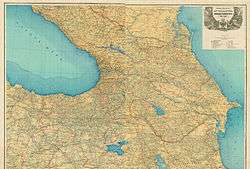Transcaucasian Commissariat
The Transcaucasian Commissariat was established at Tbilisi on 11 November 1917, as the first government of the independent Transcaucasia following the October Revolution in Petrograd. The Commissariat decided to strengthen the Georgian–Armenian–Azerbaijani union by convoking a Diet or general assembly (Sejm) in January 1918.[1][2]
| Transcaucasian Commissariat Закавказский Комиссариат Zakavkazskij Komissariat | |||||||||
|---|---|---|---|---|---|---|---|---|---|
| Autonomy of Russia | |||||||||
| 1917–1918 | |||||||||
 | |||||||||
| Capital | Tiflis (now Tbilisi) | ||||||||
| Government | |||||||||
| • Type | Commissariat | ||||||||
| Chairman | |||||||||
• 1917–1918 | Evgeni Gegechkori | ||||||||
| History | |||||||||
• Established | 11 November 1917 | ||||||||
| 22 April 1918 | |||||||||
| |||||||||
See also
- Special Transcaucasian Committee (OZaKom, Ozakom).
- Transcaucasian Democratic Federative Republic (TDFR, ZKDFR).
References
- Richard Pipes, The formation of the Soviet Union, page 103.
- Swietochowski, Tadeusz (1985). Russian Azerbaijan, 1905–1920: The Shaping of a National Identity in a Muslim Community. United Kingdom: Cambridge University Press. p. 106. ISBN 0-521-26310-7. Retrieved July 9, 2010.
This article is issued from Wikipedia. The text is licensed under Creative Commons - Attribution - Sharealike. Additional terms may apply for the media files.